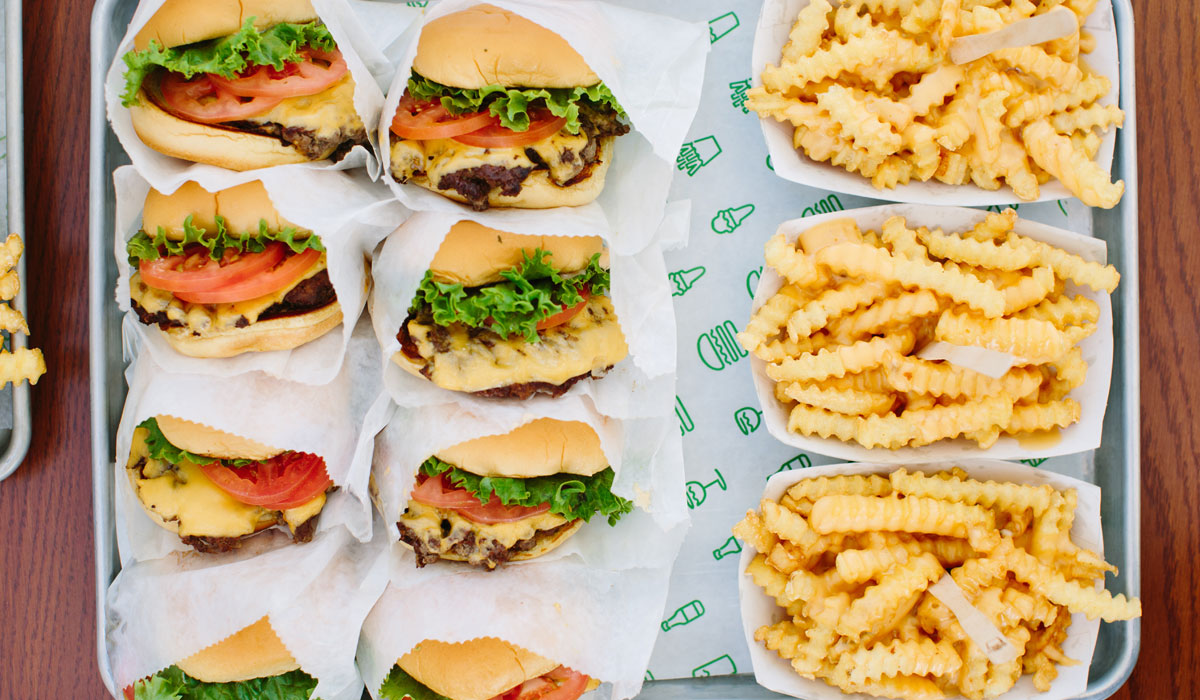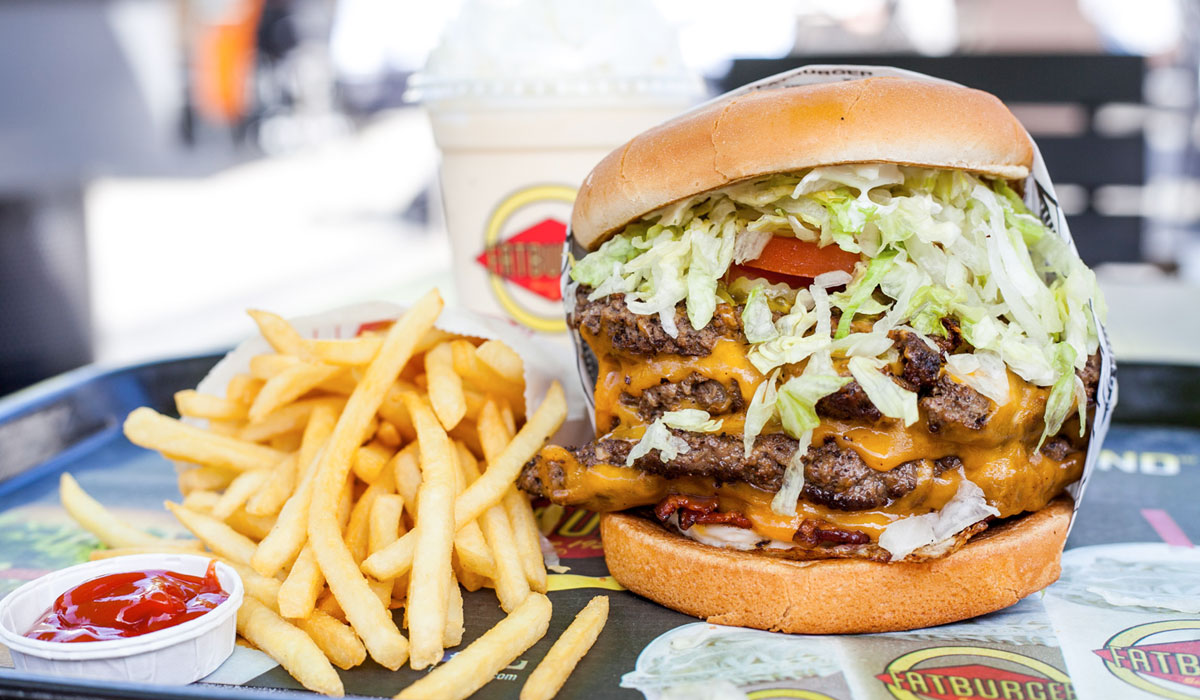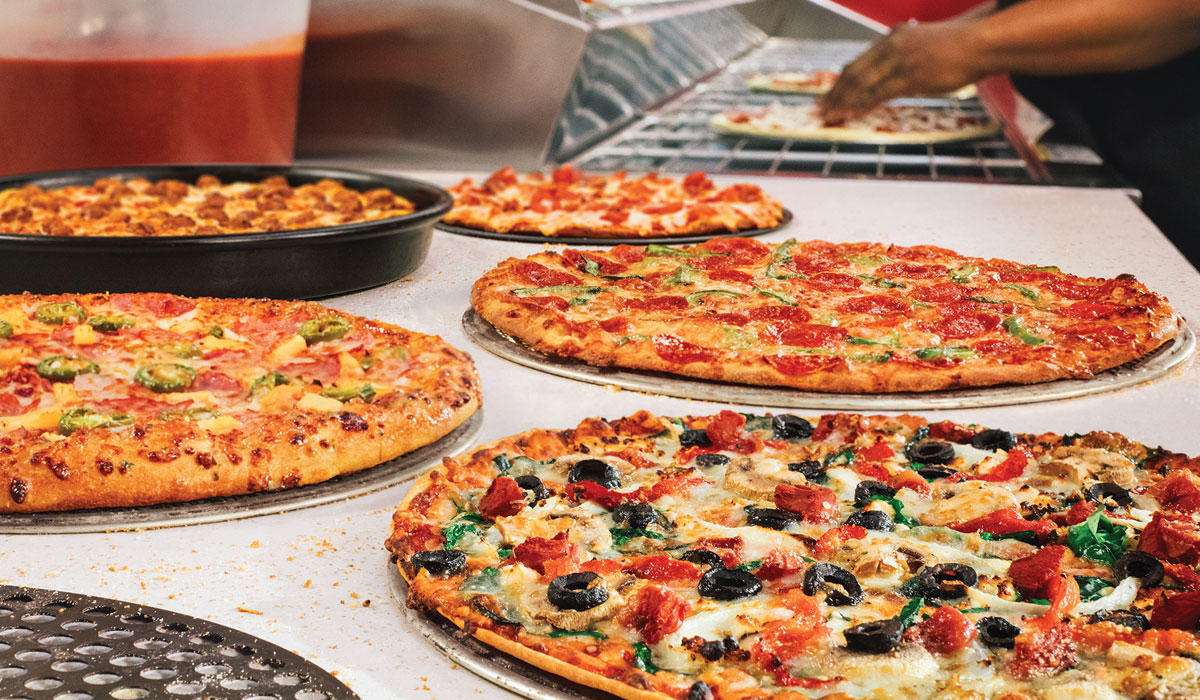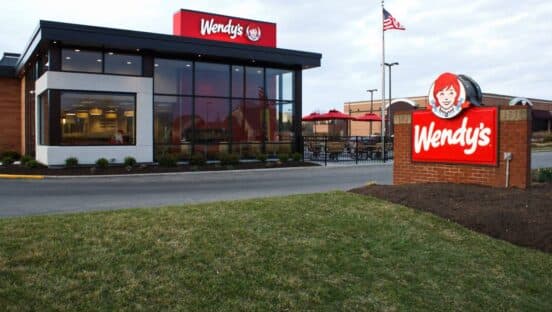Quick-service restaurant execs dissecting their brands and the foodservice industry at the ICR Conference 2020 results in some topical overlap. Hiring and retaining strong team members is arguably the biggest challenge facing brands today. Off-premises orders are booming, whether that’s through in-store platforms or third-party delivery services. And tech is spreading through every area of restaurant operations.
READ MORE: A look at the full-service news, from Darden to TGI Fridays, and more.
Most execs today will confirm that these larger trends are top-of-mind for their companies. What differentiates brands, then, are the creative ways they are responding to these overarching themes. Concepts are finding individual, brand-specific approaches to labor retention, off-premises, new tech, and other hot-button industry issues—here are some of those approaches, shared at 2020’s ICR Conference by a crew of counter-service chains.
Domino’s is continuing to shrink delivery areas to make it easier for drivers.
It’s no secret that hiring and retaining a solid stable of pizza delivery drivers is a challenge for those in the business.
“A huge opportunity is finding drivers and keeping them happy,” Domino’s CFO Jeff Lawrence said in a presentation at ICR Tuesday. “We have to pay them what you need to pay them. And, the bottom line is, our drivers are busier than your drivers.”

All of Domino’s delivery remains in-house, meaning drivers are even more crucial for the chain than for other companies that have partnered with services like GrubHub or DoorDash. What else is Domino’s doing to make jobs more attractive for drivers, in addition to competitive pay and the promise of staying busy? Continuing to shrink their delivery zones by adding new stores.
READ MORE:
Why Domino’s will be one of 2020’s biggest winners
Domino’s turns to robots to solve driver shortage
While the international pizza giant often grabs attention with tech updates like AnyWare ordering platforms and self-driving pizza cars, another area of focus for the brand is its ongoing fortressing strategy. The strategy has been in place since 2012, and Lawrence said Tuesday the brand would continue leaning into this growth plan in 2020, building more stores closer together to lessen delivery distances, wait times, and lower delivery costs.

Right now, Domino’s delivers 3.5 pizzas out of every 10 in the U.S. The chain, which has generated 103 consecutive quarters of international same-store sales growth and 34 straight domestic, plans to take a greater slice of the $85 billion global pizza industry in coming years, with the goal of building 25,000 stores and reaching $25 billion in retail sales by 2025. Eventually, the brand believes it could run 8,000 stores domestically. As of September 8, there were 5,985 stateside units (16,528 total including international).
From 2012 through 2018, Domino’s appreciated net growth of 6,172 restaurants across its system. It has added net 1,174 units in the trailing four quarters 234 total U.S.
The runway remains vast. In its top 15 markets alone, Domino’s sees potential for an additional 5,600-plus locations. The company laid out a two- to three-year outlook of 6–8 percent global net unit expansion.
Let’s just look at the developed, international slice.
U.K.
- Current: 1,118
- Potential: 1,675
Australia
- Current: 697
- Potential: 1,200
Japan
- Current: 626
- Potential: 1,000
Canada
- Current: 512
- Potential: 700
South Korea
- Current: 443
- Potential: 500
France
- Current: 404
- Potential: 1,000
Germany
- Current: 323
- Potential: 350
Netherlands
- Current: 298
- Potential: 400
In just that group, Domino’s could bump from 4,715 to 7,825 restaurants.
Emerging markets
India
- Current: 1,283
- Potential: 1,800
Mexico
- Current: 776
- Potential: 1,025
Turkey
- Current: 538
- Potential: 900
China
- Current: 251
- Potential: 1,000 (this is a big one to keep an eye on)
Saudi Arabia
- Current: 261
- Potential: 450
Brazil
- Current: 259
- Potential: 750
That shows whitespace from 3,368 to 5,925 restaurants.
And here’s how Domino’s share has evolved.
Total quick-service pizza market share
- Regional chains independents: 52 percent
- Other major pizza chains: 30 percent
- Domino’s: 18 percent
Domino’s delivery dollar share
- 2011: 21.9 percent
- 2012: 22 percent
- 2013: 23 percent
- 2014: 24.4 percent
- 2015: 26.7 percent
- 2016: 27.2 percent
- 2017: 29.3 percent
- 2018: 31.3 percent
What’s also worth noting is that Domino’s has grown its U.S. digital sales from zero to more than 65 percent in roughly a decade. The chain has driven results through order count and traffic, too, which is a rarity in quick service.
Lawrence said the pizza industry is “ripe for consolidation,” and, as Domino’s takes a larger section of that business, more drivers will be required to meet consumer needs quickly and correctly. But more stores could mean more perks for drivers and solve the driver shortage by its offer of more pizza runs—and, thus, more tips and greater mileage reimbursement.

Shake Shack is keeping things flexible to evolve along with a changing industry
Shake Shack has been around since 2004. While that’s not as lengthy of a history as other quick-serve burger giants, it’s still enough time for the chain to assess its position within current trends to ensure that it stays cutting edge.
Shake Shack is known as an urban brand, but, lately, it’s gone beyond that reputation to diversity markets and venture into places smaller than New York City like Columbus, Ohio, and New Orleans. In fact, 85 percent of stores are now outside Manhattan.
In 2020, the brand plans continuous expansion in a variety of venues like stadiums, food courts, and airports. In addition to location, store designs may see some 2020-friendly changes, too, with new front-of-house spaces being fitted for the separation of order-ahead customers and dine-in guests, and a further rollout of in-store kiosks (around two-thirds of the system already has kiosks in place).
READ MORE:
Shake Shack tweaks store model as it plots major growth
How Shake Shack inspires employee retention
The brand is also assessing the way it interacts with other big trends like the plant-based movement—while there aren’t any rumblings within Shake Shack of teaming up with a big supplier like Beyond, a new Veggie ShackBurger is currently testing in the chain’s Innovation Kitchen, and the propriety, 13-veggie patty will expand to a broader test market later in 2020. “We’re all talking a lot about plant-based proteins—how is Shake Shack thinking about this? The same way we’ve always thought about food—real ingredients making better versions of classics,” CEO Randy Garutti said at ICR Tuesday.
And, of course, Shake Shack hasn’t forgotten about the labor situation. The brand is working to offer team members career development and progression opportunities within the company; in 2019, a majority of leaders in the system were promoted from within (a majority of those promotions were also women). This year, the brand is testing out four-day work weeks for its managers.

FAT Brands is maximizing existing brick-and-mortars by adding virtual restaurants
Fast casual and casual dining franchising company FAT Brands, Inc. (Fatburger, Buffalo’s Cafe and Express, Hurricane Grill & Wings, and others) is throwing its weight behind a fresh format that allows two or more brands to share one space. President, CEO, and director Andrew Wiederhorn said in a presentation at ICR Monday that the expansion of virtual restaurants is a 2020 objective for brands Fatburger, Buffalo’s, and Hurricane Grill.
“We’re taking some of our additional brands and selling them out of the back door of existing restaurants for delivery only. In this virtual restaurant, you already have the brick-and-mortar established, so you’re adding another concept without spending more,” he said.
According to 2019 data from the National Restaurant Association, consumers report that nearly 60 percent of their restaurant occasions are now off-premises. The virtual kitchen model capitalizes on this widespread popularity, offering the delivery of multiple brands out of one single concept’s already-established physical space—i.e. a Fatburger unit can sell its own cuisine in-store, but expand that to offer the Buffalo’s and Hurricane menus through delivery in the same locations.
READ MORE: FAT Brands could buy more brands as it grows virtually
Virtual restaurants offering other FAT brands for delivery are already established within kitchens in the Fatburger system. In the case of Buffalo’s and Hurricane, the new model is yet to be introduced—Wiederhorn said that establishing and expanding this model within the two brands is a goal for 2020, along with adding more virtual locations in Fatburger stores.
Establishing these delivery-exclusive restaurants are even more efficient than building a ghost kitchen location, which requires brands to find extra space for an off-premises-dedicated store.
Thanks to its usage of already-standing brick-and-mortars, FAT Brand’s virtual restaurants can be constructed rapidly and with no added construction or unit footprint, maximizing the assets already in the company’s possession.

Noodles & Company has strengthened its brand through a turnaround, and now it’s preparing for growth with updated kitchens
When Noodles & Company started its turnaround a few years ago, CEO Dave Boennighausen said Tuesday, company needed to nail down its core strengths—noodles, variety, and portability.
The key to coming back as a brand was not apologizing for noodles, adding in low-carb options like zucchini- and cauliflower-based pastas, and firmly establishing the brand’s place in off-premises. Now that the turnaround has strengthened these fundamentals, Boennighausen said, it’s time for the chain to refocus on growth, largely through franchising.
READ MORE: Can Noodles become a growth company again?
A key preparation for this growth is updating kitchens, providing for streamlined operations and an emphasis on off-premises orders. Boennighausen said Noodles hasn’t changed its equipment in a decade, resulting in inefficiencies and opportunities for smoother back-of-house operations. Now, the chain is testing new equipment that could potentially save at least $1.8 million per hour across the Noodles system.
The equipment will reduce labor needed with newer tech, lessen the space required for a new store with systems that are smaller in physical size, and focus on off-premises orders (56 percent of Noodles orders fall into this category) with pickup windows. The fresh kitchens have been retrofitted into a handful of units, with more progress on those on tap for the year ahead.
New pricing structures are another major player in Noodles’ new look. In 2019, the brand changed its pricing, allowing for premium items to bring in higher prices than basic menu choices. The chain also added a 10 percent delivery pricing premium across all locations in October 2019 to better handle delivery costs.
“As digital becomes more and more prevalent, the really winning concepts are going to be extremely dynamic around price—[customers] encounter the brand through a user interface instead of a menu board now,” Boennighausen said.
October, the company implemented a 10 percent delivery pricing premium systemwide to mitigate the platform’s impact on margins. Additionally, Noodles & Company is testing direct delivery executed by aggregators but ordered through its native digital channels.
These upped-efficiency kitchens and smaller units, along with improved pricing and added network of strong franchisees, could be what Noodles needs to get back into growth, in 2020 and beyond.

A recently public, full-service brand to watch: Kura Revolving Sushi Bar is eliminating the need for chefs to deal with the tight labor market
Nearly the entire process at Kura Revolving Sushi Bar is automated, from robot-assisted back-of-house operations (including rice cooking handled almost entirely by robots), to a revolving service belt that transports sushi, to tablet-powered ordering. The model is one created to weather difficult labor markets.
“We have a lot working in our favor. We don’t rely on chefs—we automate chefs and are able to put more money into COGS,” CEO Hajime Uba said in an ICR presentation Monday. “We have the right business model uniquely suited to expansion. Other sushi restaurants are extremely reliant on executive chefs—hiring, training, and retaining these chefs is difficult.”
READ MORE:
Kura gets off to a great start, sales wise
Why Kura will hit 300 locations, and then some
This is the tech-heavy concept’s first year as a public company. The brand is backed by Kura Sushi Japan, a company that has more than 400 restaurants in Japan. Since opening up in California in 2009, Kura Sushi has grown to 24 units in the U.S., with a goal of opening around 300 stores domestically in the future.
The Kura Sushi process is futuristic: Guests enter and are seated, take whatever they would like from the revolving belt of sushi items created mostly by automation, and order whatever they don’t see on the belt via tablet. Beverage-wise, the brand is currently testing bulking up its options, including allowing guests to also order drinks via touch panel as well.
The heavy emphasis on automation not only reduces staff needed, it also cuts costs when it comes to training—an area of operations that can be expensive for sushi restaurants that require highly-skilled chefs. This drastic cost-saving, in turn, allows better value for guests, offering a varied, high-quality menu at a lower cost than high-end restaurants in the same category.
Of course, even with this bevy of automation, human managers are still needed for locations. To reduce turnover in this non-automated category, Kura Sushi recently began offering company stock to managers, offering them a vested interest in the business and a greater reason to stay in the fold.










